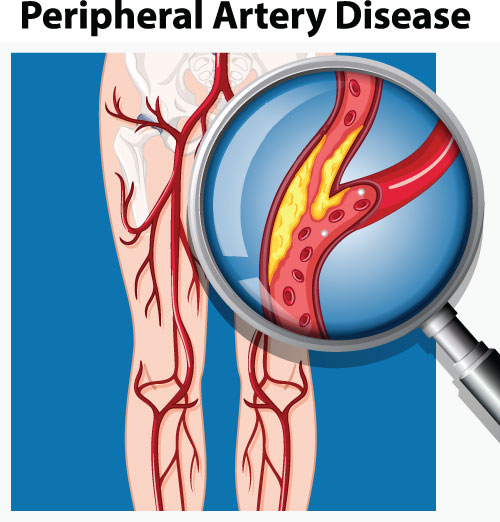Peripheral Arterial Disease
The interventional Radiologists at MRA specialize in the diagnosis, treatment, and care of peripheral arterial disease.

What is peripheral arterial disease?
Peripheral arterial disease (PAD) is a narrowing or blockage in the blood vessels supplying the legs. This is most commonly caused by the build-up of plaque inside the blood vessels. Risk factors include:
- cigarette smoking
- diabetes
- high cholesterol levels
- high blood pressure
When the blood vessels to the leg become narrowed, pain and discomfort known as “claudication” can occur. This is most commonly described as cramping pain in the buttock, thigh, calf, or foot, that occurs with activity, and is relieved by rest. It occurs because the muscles of the leg cannot receive the blood (and oxygen) they need to properly function.
When the disease becomes severe, it can even cause pain while resting (often at night while lying flat), or wounds of the legs or feet which do not heal.
Typically, your primary health care provider will first assess your symptoms and perform a physical exam. If these suggest that PAD is possible, there are a few non-invasive tests which may help confirm the diagnosis. These involve measuring blood pressure in the legs or using imaging to assess the blood flow in the vessels.
Patients with PAD and claudication should receive treatment. The first step is often making lifestyle changes such as quitting smoking and exercising more. There are also medications to help treat the disease. These lifestyle changes and medications also help reduce risk of other cardiovascular events (like stroke or heart attack). This is important because patients with PAD often have disease in the vessels that supply the heart and brain as well.
After lifestyle changes and medication, if a patient continues to have leg pain (“claudication”) which interferes with their activities, then they may be a candidate for a procedure to restore blood flow to the leg. This can be done using minimally invasive techniques (endovascular treatment), or with open surgery.
Through an incision in the groin about the size of pea, a specialist will introduce a thin, flexible tube (called a “catheter”) which is advanced inside the blood vessels to the site of blockage. Depending on the nature of the diseased artery, various interventions can be performed to help restore flow, all of which are performed under real-time imaging guidance:
- Atherectomy: the plaque blocking the blood vessel can be shaved off
- Angioplasty: a balloon is used to open the blood vessel
- Stenting: a metal mesh tube can be placed to keep the vessel open.
The decision to perform endovascular treatment or surgery depends on several factors including the location and length of the blockage. With advances in techniques and devices over the past few decades, most patients are now candidates for Endovascular treatment, allowing them to avoid surgery. Advantages of endovascular therapy include:
- No surgical incision
- Shorter recovery time
- Less discomfort
- No need for general anesthesia
- Less strain on the heart
- Lower risk of infection
Endovascular treatment for PAD is typically covered by insurance. Your out-of-pocket expense will depend on your specific insurance plan.
Request a consultation today:
One of our expert Interventional Radiologists will personally review your imaging and case with you, and help develop a treatment plan that is right for you.
Patients, please note that services may require a referral from your primary care or another provider, but we can help facilitate that process if treatment is deemed necessary. Telehealth consultations may be available depending on the type of procedure required.

